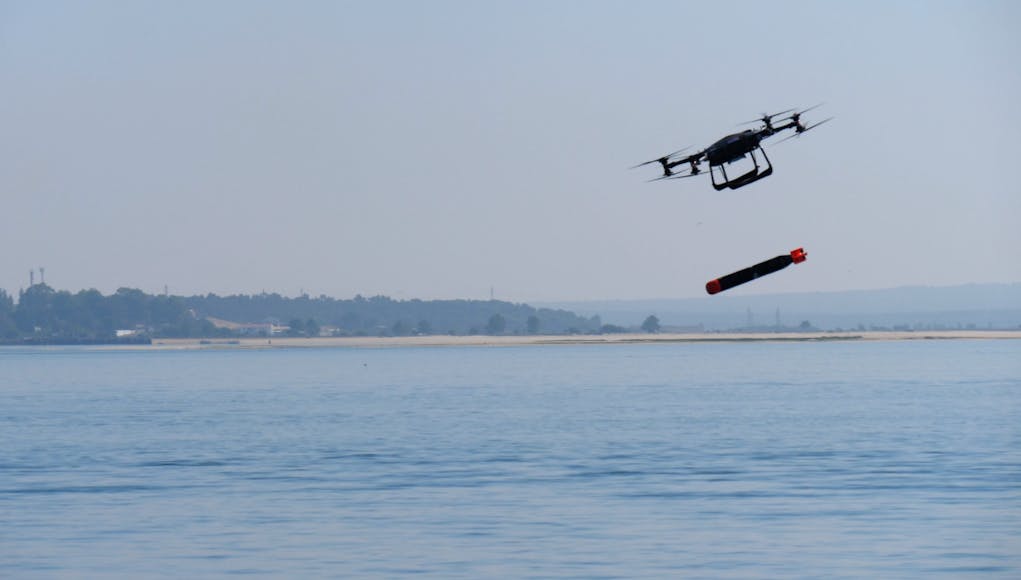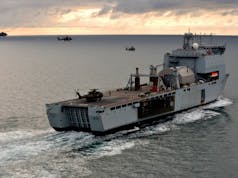BAE Systems and Malloy Aeronautics have demonstrated the capabilities of the T-600 heavy lift uncrewed air system (UAS) during a large NATO exercise in Portugal to integrate the very latest maritime technologies across allied forces.
The T-600 is an electric-powered demonstrator aircraft capable of vertical take-off and landing, can carry a payload of 200kg and can travel at up to 140km/h.
It also has a range of up to 80km depending on payload. It is around the size of a small car and is designed to be easily disassembled for transportation. During the multinational exercise, the demonstrator successfully released an inert Sting Ray training variant anti-submarine torpedo during a flight mission at sea for the first time.
The exercise known as REPMUS (Robotic Experimentation and Prototyping with Maritime Uncrewed Systems) involved 15 NATO partners, along with Ireland and Sweden. It provides a safe and controlled area to test concepts, requirements, new and advancing technologies in respect of Maritime Uncrewed Systems.
The T-600 demonstrator is designed to develop, validate and display technologies which may be applied to the T-650, a completely new design of an all-electric heavy lift UAS which will offer rapid reconfiguration capabilities applicable to military, commercial and humanitarian uses. The T-650 will provide significant capabilities in the areas of automated logistics and resupply, casualty evacuation and anti-submarine warfare whilst reducing the environmental impact of the armed forces.
Neil Appleton, Head of Electric Products, BAE Systems’ Air sector, said:
“In just two years since we launched our collaboration with Malloy, we’ve developed a heavy lift UAS and, working with the UK Royal Navy and Portuguese Navy, have taken part in the latest NATO REPMUS exercise. The demonstration showcased the capability of our T-600 technology demonstrator, carrying an inert Sting Ray torpedo in front of the world’s premier naval forces. It’s a fantastic achievement in our collaboration with Malloy and a sign of our joint ambitions to bring new capabilities to our customers.”
Dave Quick, Head of Underwater Weapons, BAE Systems’ Maritime Services, said:
“Our development of Sting Ray Mod 2 is focussed on weapon effectiveness and increasing the ways in which the torpedo can be deployed. We’re extending the breadth of supported platforms and maturing new torpedo deployment mechanisms, including drones, to explore the operational benefits to anti-submarine warfare and anti-torpedo defence.”
Oriol Badia, CEO of Malloy Aeronautics, said:
“At Malloy Aeronautics, we are committed to turning concept ideas into real capabilities fast. Our smaller T-150 UAS have been tested and operated for years by the UK MoD and US DoD, but the T-600 has gone from concept to operational demonstrator in record time for a vehicle in this payload class.
The collaborative success seen at REPMUS adds to the list of promising capabilities being tested with this platform (last-mile resupply and CASEVAC), and proves that modular, multi-mission UAS can reduce the logistics burden and increase operational tempo at a fraction of the cost.”














Fantastic news.
I’d be fascinated to see the same drone dropping sonar buoys – which is the easy bit and something that can hover as a relay?
I wonder if it can be a dipper too?
Leonardo Proteus mockup in collaboration with UK MOD unveiled at DSEI 2023 have 3 modules, Sonobuys, Lighweight Dipping sonar – but i wonder how much depth can it get do to winch and cable weight – and Cargo module. But it is vehicle of 2-3t class so heavier than this one.
Bae Australia are pushing the Strix uav that fits in a TEU for use in T26 which has options such as dipping sonar
The BAE Strix looks really neat and I has been shown to also carry Sea Venom.
https://www.baesystems.com/en-aus/strix
worth keeping an eye on its performance.
Surely if the drone is dropping a torpedo which uses it’s own power to move around and reach any depth then that is the way to go. Retrieval would then be the issue.
Must be some confusion or i am not seeing what you trying to say. I am talking about a dipping sonar, that needs a winch with cable.
Sorry I wasn’t making myself clear. With a drone the weight of a winch is not practicle with small drones therefore if you take a torpedo remove the charge and add any additonal sensors that might give you a solution. In theory you could ditch the propulsion element and recover the sensors to the drone.This way you wouldn’t need the winch & only a light communications cable.
https://www.navalnews.com/event-news/euronaval-2022/2022/10/thales-working-on-dipping-sonar-technology-for-uavs/
The technology breakthrough is the cable diameter !
So a disposable rather than recoverable towed sonar?
networking a squadron of drones to operate in a ASW role is an exciting concept and in the T650 in the right conditions,become a real game changer one on each ship in say the CSG, if a threat is detected sent up as a torpedo carrying torpedo squadron up against it would a very cheap alternative to an expensive merlin type help. add the networking abilities deploying sonarbkys and having the abilities to dip sona.
It seem like a no brainer to me, you could operate 1 with sonar bad buoys and a 2nd with stringray, but wot do I know….😎
This gets me wondering, have General Atomics/MOD tested dropping a torpedo and/or sonar buoy from a Protector yet? I wonder if that’s on the to-do list?
This is very cool. Good to see the T-600 being worked up, and I think there’s still the aspiration to develop the T-650 with the 300kg payload. Malloy really seem to be all over these Class 2 eVTOL quadcopters.
Let’s hope that can also translate into exports, with the US Navy already buying into the lighter T-150 for tactical resupply.
well, the T-650 won’t be much good at dropping the Stingray unless the payload is worked up to the 300kg category, as the bare lightweight torpedo weighs in at 267kgs!
I noticed there was mention of Stingray Mod 2, which I’ve not heard of before. I wonder if it’s lighter.
200kg is certainly lighter. I think that would make it the lightest of the LWTs with that warhead size. Not heard of mod 2 either, must be an internal project although surprised I didn’t see anything on it come out at DSEI.
SR is at Mod 1 now. In effect it’s a new torpedo in all but name. New warhead, battery/power control, processors, sonar transducers, actuators.
Mod 1 addressed obsolescence issues throughout the weapon and the big safety concern that existed with the legacy warhead.
Mod 2 will be much the same. Obsolescence issues addressed, new tech for processors and sonar etc.
The weapon gets software updates as well. All the test shots for EVT (Exercise Variant) which is a runner with a telemetry head in place of the warhead are analysed for performance against various targets and parameters. This is used to improve the weapons software.
If I remember correctly the software updates are done without breaking open the weapon. The software is transmitted into the weapon via the hull without a cable.
Well it’s claimed max payload is indeed 300kg, so seems to be on the right track though 30 mile range at that payload is a little limiting but even at that, let alone further development it would be useful support for the Merlin esp operating off of escorts, certainly in covering gaps in coverage. And that’s only one of its attributes it’s flexibility in terms of sensors and weapon load will be a great asset.
Carrying 7 Merlin anti-submarine helicopters on the carriers and 2 more on a pair of Type 23/26 takes up a lot of space, manpower, and energy for a carrier strike group. If the Royal Navy did nothing else with drones but focused on having them takeover every aspect of the Merlin’s anti-submarine role effectively, it could still have huge benefits for the strike group.
Supplement and assist would be excellent. Merlins and wildcat have space in the back for operators.
One of the issues with drones will be using them reliably in gps dead zones, Highly saturated communication areas.
I don’t know enough about secure data links and how vulnerable they are to jamming or how to communicate over range, high bandwidths etc. until the drones can think and act for itself its always going to need connected to somewhere.
Being connected to the helicopter in line of sight could be more reliable than a ship beyond the horizon.
or …a drone at altitude acting as a comms relay!
Replace existing long endurance and bigger payload helicopters with light duty drones.
Even this demonstration doesnt add up as the 13 in Stingray ( live round) comes in 267 kg and of course 80 km is only 40km there and back with hardly any hovering
They clearly left the warhead off , but didnt have a matching weight
Good points. You might be right my statement was too ambitious. I myself would want at least a couple of Merlins for a QRA type of anti-submarine role. We all know the Merlins do their job extremely well. But these are just those old suitcase drones designed for light transport. It seems all the drone projects so far from the RN have been very low cost air-frames from very small companies to look at potential capability. I think they are at least letting us imagine . . . My point was more to the fact that if you have 14 Merlins doing AEW & airborne ASW in the strike group, and taking up the same amount of parking space as F35Bs, that would be a great place to go after some of the efficiencies that drones might have to offer.
see my comments ref TVT configurations. And yes they need a bigger capacity drone for a warshot
Range of 80km and speed of 140kmh = somewhere around 35 minutes flight time with low payload, about right for most electric multi rotors. This is their biggest problem atm.
I agree but in a way this is proof of concept work moving towards the day it all. becomes practical. There is some very interesting battery technology coming along within the next decade Aluminium Sulphur and Aluminium Graphene being but 2 with much lighter weight and potential for doubling range so worth doing the work required to take advantage as and when they arrive.
This is the remote system of the future actually here now!
I wonder if they could develop a version of Stingray that combines the roles of sonarbuoy and towed array, without a warhead? Which is then transported to a drop point by something like this T600 drone. The Stingray “Seeker” then operates some distance away from the ship to hunt a possible contact. Which if found, is relayed back to the ship for another T600 to drop a Stingray weapon on.
After the mission is completed or the “Seeker” runs out of power, it floats to the surface and is recovered back to the ship by the drone. Instantaneous communications between the ship and the Seeker would be a problem. But the Seeker could release communications buoys that contains the Seeker’s data. Which may be enough to get an idea of whether the contact is worth prosecuting.
Not sure if I’m allowed to post this as all of my posts are still waiting for approval.
Thales Working On Dipping Sonar Technology For UAVs
“The small diameter cable is “less than 3 mm thick” and has an impressive length of “about 700 meters”. It is made of synthetic material and is not only strong enough to carry the weight of the dipping sonar, but it also transmits information from the sonar to the UAV. Once the UAV receives the information it relays it to all the other platforms – MPA, helicopter and/or ship. The use of this cable to enable tracking via UAVs offers more flexibility and speed: as the submarine moves, the UAV can simply roll the cable back in to extract the dipping sonar from the water – an operation far less cumbersome than reeling the sonar back into a helicopter – and move to the next position to deploy it again.”
LINK
Could do it with a REMUS ?
Hi GB, I had to look up what a REMUS was. But yes, something along those lines. SO the idea is not completely bonkers? As it looks to be a comparable size to Stingray. If its used for mine detection using a sideways looking sonar, then a passive sonar array is not that much different. Just was wondering if something this small, would be able to tow a small hydrophone array?
Developing nicely.
Now when will we see them in service rather than another round of trials to “inform decisions” that never arrive before the next round starts.
Yes, I know, I’m very impatient with all this as it seems never ending.
Agree, most shocking thing about this trial is it was not in service 10 years ago. We only do what the US does and the US is notoriously man power intensive and has also been slow to pick up drones.
No so shocking . The big development funded by private industry in rechargeable batteries which are affordable, driven by say car industry What was available even 10 years ago wouldnt have gone 5km.
technology advances remember
Particle swarm theory applied to hunting submarines. What an excellent concept. And now they can commit the attack. So ASW assets could focus on drone operating capacity, and use the helo more for coordination.
I’m old enough to remember the stories of the problems the USN had with the QH-50 DASH torpedo carrying drone in the 1960s. Loss rate of the drones was high. Improved control and encrypted comms should make this drone much more reliable.
The RN has more Admirals (34) than ships of the line. Maybe retire some and put the money towards converting redundant oil rig supply vessels to act as mother ships for UAV’s to form a picket line on the UK-Iceland-Greenland gap.
Encouraging. We must have ASW prosecution capability in all future escorts. Even River OPV’s & RFA’s might be able to use these. Martlet next?
Martlet was test fired from the far smaller Turkish Jackal drone, whose IP was transfered to the British company FlyBy. It looks like this will be fully developed because of a Taiwanese order only last week.
Whether the UK goes with Jackal for Martlet, we shall see.
Unless it’s made by general atomics and the company employs the correct number of ex uk service chiefs we won’t be getting it.
I found this on the Turkish website DefenseHere.com:
so I’m keeping my optimistic hat on. I’m not sure what use-case the Army has in mind. Starstreak or NLAW comes to mind. I’d have thought there were enough ISTAR platforms in the mix.
The drone, already significantly increased in power over the last eighteen months, is expected to get even bigger from the 6 ducted-fan version we see today, through adding a turbogenerator.
And the wheel turns. I seem to remember the USN Gearing Class FRAM conversions withe the DASH system in the late 50s/early 60s.
With my Air Weapons back endy FF/DD head on…
Sting Ray is nearly 300kg in warshot configuration with Flight In Air Material (FIAM) attached.
FIAM is
The weapon dropped in the trial is a TVT that is used in one of two configurations. Air carriage and handling with lead weights fitted in it to make it representative for loading and carriage. It does not float if dropped.
In lightweight mode it’s got no lead weights in it so its buoyant when dropped and can be recovered.
Using a drone as a pony to carry a torp is a great idea. It’s certainly cheaper than using a Wildcat as the pony. Not having 2 x 300 Kg SR hanging off a Merlin dipper means more fuel and more range and endurance for sub hunting.
The ability to fly in roughers and heavy weather may be an issue for the drone.
Interesting to see that they are looking at other ways of deploying SR Mod 2. I would expect something like a Cube system launcher and mag system, UAV Malloy drone and possibly a simple gravity drop angled tube on a 11m remote control workboat? You could have the Workboat that pootles off ahead of the mothership and releases a torp that slides out of a simple angled tube into the water to attack the sub. A sub would/may have issues detecting a waterjet 11m workboat in the littoral or even open ocean against surface noise. The workboat could be 40-50 miles out ahead.
https://www.saft.com/products-solutions/products/primary-and-rechargeable-silver-zinc-systems-torpedoes/
Batteries by these guys.
Just seen a better picture.
The SR has inbuilt suspension lugs that are spring loaded to fold flat after release from a weapon carrier so as not to affect torpedo streamlining in the water for its high speed. It appears that this is the way that SR was attached to the drone. No need for suspension bands and so saving weight. You still need an EMRU ( electromagnetic release unit) on the drone to release the torp but one of those is going to be there no matter what with either 29 lugs or suspension bands.